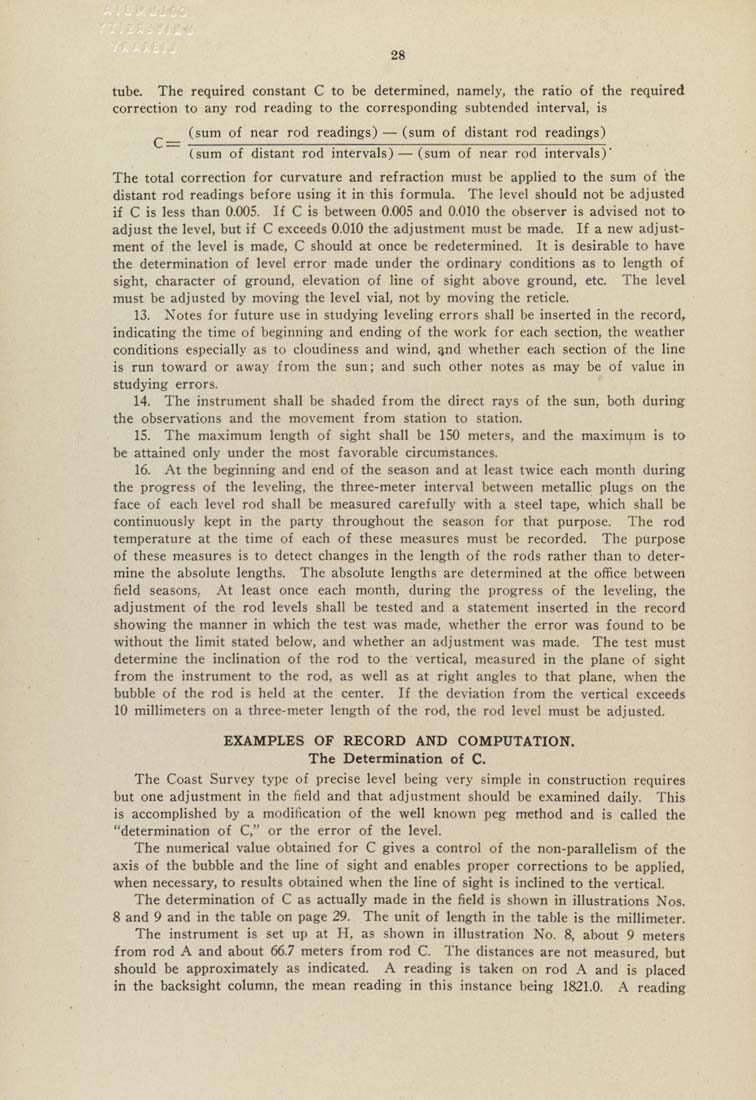28
tube. The required constant C to be determined, namely, the ratio of the required
correction to any rod reading to the corresponding subtended interval, is
(sum of near rod readings) — (sum of distant rod readings)
(sum of distant rod intervals) — (sum of near rod intervals)'
The total correction for curvature and refraction must be applied to the sum of the
distant rod readings before using it in this formula. The level should not be adjusted
if C is less than 0,005, If C is between 0.005 and 0.010 the observer is advised not to
adjust the level, but if C exceeds 0,010 the adjustment must be made. If a new adjust¬
ment of the level is made, C should at once be redetermined. It is desirable to have
the determination of level error made under the ordinary conditions as to length of
sight, character of ground, elevation of line of sight above ground, etc. The level
must be adjusted by moving the level vial, not by moving the reticle.
13. Notes for future use in studying leveling errors shall be inserted in the record,
indicating the time of beginning and ending of the work for each section, the weather
conditions especially as to cloudiness and wind, gnd whether each section of the line
is run toward or away from the sun; and such other notes as may be of value in
studying errors.
14. The instrument shall be shaded from the direct rays of the sun, both during
the observations and the movement from station to station.
15. The maximum length of sight shall be 150 meters, and the maximum is to
be attained only under the most favorable circumstances.
16. At the beginning and end of the season and at least twice each month during
the progress of the leveling, the three-meter interval between metallic plugs on the
face of each level rod shall be measured carefully with a steel tape, which shall be
continuously kept in the party throughout the season for that purpose. The rod
temperature at the time of each of these measures must be recorded. The purpose
of these measures is to detect changes in the length of the rods rather than to deter¬
mine the absolute lengths. The absolute lengths are determined at the office between
field seasons, At least once each month, during the progress of the leveling, the
adjustment of the rod levels shall be tested and a statement inserted in the record
showing the manner in which the test was made, whether the error was found to be
without the limit stated below, and whether an adjustment was made. The test must
determine the inclination of the rod to the vertical, measured in the plane of sight
from the instrument to the rod, as well as at right angles to that plane, when the
bubble of the rod is held at the center. If the deviation from the vertical exceeds
10 millimeters on a three-meter length of the rod, the rod level must be adjusted.
EXAMPLES OF RECORD AND COMPUTATION.
The Determination of C.
The Coast Survey type of precise level being very simple in construction requires
but one adjustment in the field and that adjustment should be examined daily. This
is accomplished by a modification of the well known peg method and is called the
"determination of C," or the error of the level.
The numerical value obtained for C gives a control of the non-parallelism of the
axis of the bubble and the line of sight and enables proper corrections to be applied,
when necessary, to results obtained when the line of sight is inclined to the vertical.
The determination of C as actually made in the field is shown in illustrations Nos.
8 and 9 and in the table on page 29, The unit of length in the table is the millimeter.
The instrument is set up at H, as shown in illustration No. 8, about 9 meters
from rod A and about 66,7 meters from rod C. The distances are not measured, but
should be approximately as indicated, A reading is taken on rod A and is placed
in the backsight column, the mean reading in this instance being 1821,0. A reading
|








